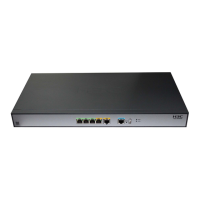62
Configuring WLAN QoS
The terms AP and fat AP in this document refer to MSR800, MSR 900, MSR900-E, MSR 930, and
MSR 20-1X routers with IEEE 802.11b/g and MSR series routers installed with a SIC WLAN module.
Overview
An 802.11 network offers contention-based wireless access. To provide applications with QoS
services, IEEE developed 802.11e for the 802.11-based WLAN architecture.
While IEEE 802.11e was being standardized, Wi-Fi Alliance defined the Wi-Fi Multimedia (WMM)
standard to allow QoS provision devices of different vendors to interoperate. WMM makes a WLAN
network capable of providing QoS services.
Terminology
• WMM—A wireless QoS protocol designed to preferentially transmit packets with high priority,
thus guaranteeing better QoS services for voice and video applications in a wireless network.
• Enhanced distributed channel access (EDCA)—A channel contention mechanism designed
by WMM to preferentially transmit packets with high priority and allocate more bandwidth to
such packets.
• Access category (AC)—Used for channel contention. WMM defines four access categories;
they are AC-VO (voice) queue, AC-VI (video) queue, AC-BE (best-effort) queue, and AC-BK
(background) queue in the descending order of priority. When contending for a channel, a
high-priority AC queue preempts a low-priority AC queue.
• Connection admission control (CAC)—Limits the number of clients that are using
high-priority AC queues (including AC-VO and AC-VI queues) to guarantee sufficient bandwidth
for existing high-priority traffic.
• Unscheduled Automatic Power-Save Delivery (U-APSD)—A new power saving mechanism
defined by WMM to enhance the power saving capability of clients.
• SpectraLink voice priority (SVP)—A voice priority protocol designed by the SpectraLink
company to guarantee QoS for voice traffic.
WMM protocol
The distributed coordination function (DCF) in 802.11 stipulates that access points (APs) and clients
use the carrier sense multiple access with collision avoidance (CSMA/CA) access mechanism. APs
or clients listen to the channel before they hold the channel for data transmission. When the specified
idle duration of the channel times out, APs or clients randomly select a backoff slot within the
contention window to perform backoff. The device that finishes backoff first gets the channel. With
802.11, all devices have the same idle duration and contention window. Therefore, they are equal
when contending for a channel. In WMM, this fair contention mechanism is changed.
EDCA parameters
WMM assigns data packets in a basic service set (BSS) to four AC queues. By allowing a
high-priority AC queue to have more channel contention opportunities than a low-priority AC queue,
WMM offers different service levels to different AC queues.
WMM define a set of EDCA parameters for each AC queue, covering the following:
• Arbitration inter-frame spacing number (AIFSN)—Different from the 802.11 protocol where
the idle duration (set using DIFS) is a constant value, WMM can define an idle duration per AC

